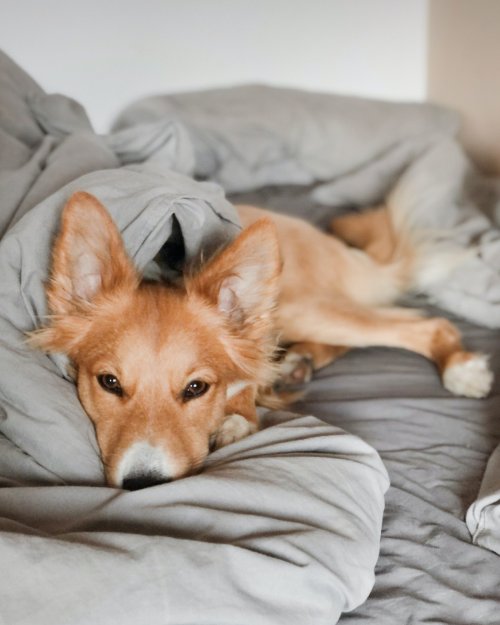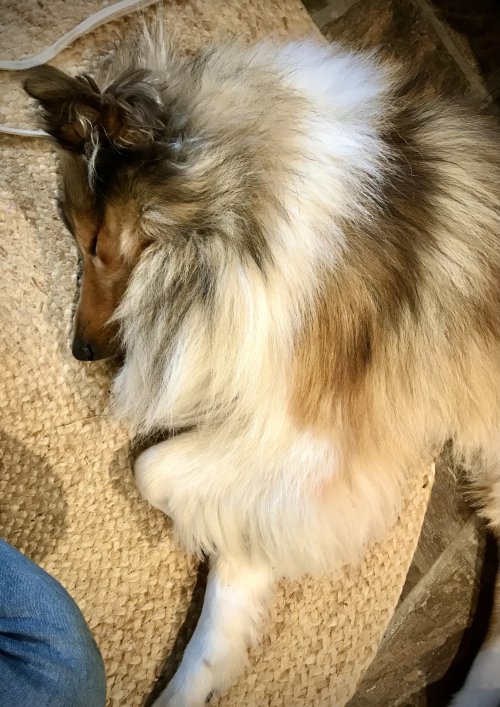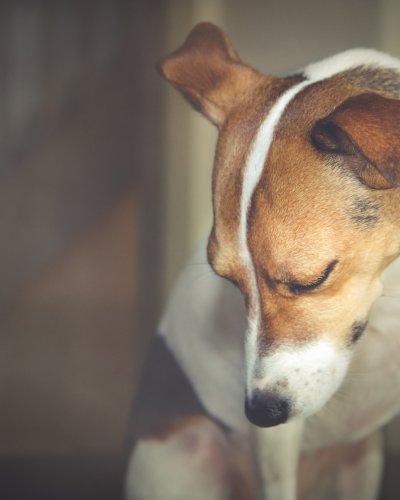How to calm your Dog down
Wanting your dog to be happy and relaxed is a goal of many owners. However, achieving this is not always easy. Some dogs may feel overwhelmed or anxious without an obvious reason. In this article, we will be looking at physical, physiological and emotional triggers that might make dogs restless and ways to help them remain calm.
Understanding Why Your Dog Isn't Calm

The answer to why your dog isn't calm is not simple. Since the reasons for heightened arousal or stress can vary, it may be best to consider the most obvious and potentially painful reasons first—an injury or any other physical source of pain. This is especially important if unusual behaviour appears suddenly or your otherwise calm dog changes their behaviour overnight.
If you've noticed a sudden onset of heightened stress or behavioural changes, it's best to take your dog to the vet, as they can rule out and diagnose underlying health issues that might cause your dog's problem.
Once you've ruled out injury or illness, and your dogs keep showing signs of restlessness, it's time to look at the bigger picture and dig deeper in the search for the causes of unrest. Start by observing your dog; try to discover if certain situations proceed or exacerbate your dog's stress. The core of the problem may stem from environmental, emotional, psychological, or biological issues that, until now, have gone unnoticed.
Psychological Reasons
Psychologically, several reasons can cause a restless state in dogs. Very often, restlessness is expressed as a consequence of one of the following:
Stress
How each dog reacts to or interprets a situation can be vastly different, even to the extent that a certain situation causes joy for some and yet is a source of stress for others. An example is riding in a car—some dogs love it, while others will experience and display high levels of unrest or even motion sickness. They might pant, shake and whine excessively and even jump towards the window, making driving unsafe.
Anxiety
Triggers that lead to a dog feeling anxious can also differ — for some it may be unfamiliar people (guests) in the house, a walk in a noisy part of town, or going to a place crowded with dogs. A common form of anxiety is separation anxiety, where the dog experiences anxiety when left alone or is separated from their human. Signs of anxiety may include constant pacing, barking and clinginess.
Excitement
Playing highly stimulating games with a dog can be fun, but if we only interact with the dog in a state of high arousal, it can impact their ability to self-regulate. Through repeated high-arousal games, and in the absence of teaching dogs to play or interact at lower levels of arousal, they may inadvertently learn to only interact with us in a state of high arousal. This can affect the dog's ability to learn and inhibit undesirable behaviours. We have devoted an entire article to arousal in dogs, which will help you recognise the signs that your dog is reaching the threshold of the optimal training zone.
Fear
Various things can trigger fear, which is generally related to the dog's experiences. However, many dogs fear loud noises such as fireworks or thunder; others still fear strange people on the street or other dogs. It's important to recognise our dog's fear signs and respond with kindness and compassion, even if those fears seem irrational.
Dogs suffering from fear may display manic barking, tail chasing, pacing, mounting, and licking. They often avoid direct eye contact because this kind of communication can overwhelm them.
Biological Aspect
Besides psychological reasons, the biological aspect greatly determines how nervous or calm dogs are. Consider that each dog has a biological bandwidth on the calmness scale. And while some dogs are by nature more prone to chill behaviour, others are naturally in the high vigilance zone. It may be hard and sometimes even impossible to turn a high-vigilance or hyperactive dog into a chill one, but that’s fine. Each individual, even within a breed type, has different traits, and we should meet each dog where they are while trying to make their and our lives happier and better.
Signs of Restlessness
Dogs communicate their lack of calmness in many ways. Some dogs are more subtle, which may not register on our radar until those signs escalate. Therefore, learning to read your dog's body language can help us to understand them better.
According to Dr Susan Konecny, medical director of Best Friends Animal Society, our dog will show restlessness through one or more of the following signs:
Pacing
Trembling
Shaking
Hypervigilance
Lip licking
Frequent yawning
Decreased appetite
Increased salivation or drooling
Dilated pupils
Increased heart rate and panting
Skin lesions from self-trauma
Over-grooming
How to Help Your Dog Learn to be Calm

Learning to recognise signs with which your dog is communicating it is feeling restless allows us to try then to identify what triggers caused this behaviour.
Some pet parents keep a journal and describe their dog's behaviour on paper to track its cause more successfully. Identifying triggers involves observing whether the behaviour is linked to any specific situation or environment and how often it repeats.
Reviewing these notes should help you more easily detect the triggers that cause fear, stress, or other reactions in your dog.
Remove Possible Pain Triggers
Unidentified pain can be a common source of stress, so if your dog is having trouble with being calm, it's one of the first things you can address. Canine therapists work hands-on with your dog to release areas of tension or pain that might have gone unnoticed.
Thermal imaging wellness checks are a popular choice to help better understand the physiological state of the dog. This safe and non-invasive examination can identify potential dysfunctions in your pet's body. They can occur on a neurological or nerve-related level, showing up on thermal imaging as hypothermia (cool areas) or hyperthermia (hot areas) which are linked to potential inflammation, such as in joints. Your therapist can further refer you to a vet or, in severe cases, to veterinary behaviourists—experts in treating fear, anxiety, and aggression in pets.
Remove Triggers That Cause Your Dog’s Anxiety
If you notice triggers coming from the environment (for example, your dog is afraid of other dogs), it may be best to avoid those triggers temporarily. For example, don't go to the dog park for a while, but go for walks where the concentration of dogs is smaller, and your dog can observe other dogs from a safe distance. If your dog shows anxiety in the presence of people passing by on the street, try to keep it away from the part of the yard that overlooks the street or put up a visual barrier.
Of course, these are not permanent solutions, but only a way to calm the dog and move away from wherever is causing it stress. Adapting to the triggers will be necessary sooner or later if we want a truly happy dog, and if we want to avoid problems and worries every time we go out with our pet. Such training may require the help of experts.
Help Your Dog Achieve Emotional Balance
Emotional balance is a set of skills that include the individual's ability to influence emotional expression, duration, and intensity. Emotional regulation can be automatic or controlled, conscious or unconscious, affecting one or more points in the emotion-making process.
To help our dogs learn how to be calm and maintain that state, we need to guide them towards a neutral valenced emotion where it will be challenging to trigger them. Some dogs achieve this emotional neutrality easily and naturally, and for others, it can be a real challenge and a space where our dogs require our support.
Create a Sanctuary Space

Some dogs can bring their state of fear and anxiety to such a level that it becomes impossible for their owners to calm them down. But before you reach out for anxiety medication, Dr Konecny advises that dogs with such a condition should have a quiet space in their home without any stimulation, where they can completely switch off and simply unwind. It can take several hours, even more than a day for the nervous system to calm down after a stressful event.
This safe space in the home is especially important for dogs who find it difficult to maintain a calm state when, for example, guests are over or who are afraid of loud noises, such as thunderstorms or fireworks. Research has shown that music therapy can have s calming effect on dogs, especially ambient or classical music—just be sure to keep the volume low. For other dogs, any white noise machine can work wonders because the even sound minimises the stimulus of other more distressing sounds. But all this should be approached with the aid of experts because however calming to us, these sounds may also trigger a severely scared or anxious dog.
Waiting for a Calm Behaviour
The solution to our problems is often much simpler than it seems at first glance. Maybe only by making small changes in our behaviour towards dogs, we can allow them to behave more calmly.
For example, if your dog jumps on you and it's over-excited when it's time to eat, wait patiently until it calms down and only then put the bowl on the floor. In another scenario, if it shows restlessness and excitement when you’re going for a walk, teach your dog that the door will open only when it sits and calmly waits. It can also be a real exercise in patience for dog owners, but the benefits for both parties are worth the effort.
Helping Your Dog Be Calm Through Play
Sometimes when we are tense the best way to relax is through a little fun time. The same thing works in the dog world!
If your dog shows signs of excess energy, allow them to release it with good physical exercise. A fun way to physically tire a dog out and at the same time bond with your pet is by playing tug. In the video How to Safely play Tug with your Dog we explain the benefits of this game, how to play it safely and what to watch out for.
When playing with your dog, always keep its arousal level in mind. We don't just want to push the dog towards constantly higher arousal, which will cause even more restlessness, but we want to maintain the fluctuation between states of calmness and excitement through play.
Therapy for Calming Your Dog

The old saying is true: a healthy mind in a healthy body! The dog's physical state is related to its psychological and emotional state. So, when the dog is physically healthy, and its body functions at an optimal level, the load on the mind is also reduced. Therefore, manual therapy is sometimes welcome, if not necessary, in relieving pain in your dog's body and making the dog calm again.
Manual therapy refers to techniques used to improve the movement of joints, muscles and other soft tissues. This hands-on technique includes massage, osteopathy, Bowen, and EMMET therapy. It aims to improve joint range of motion and posture to alleviate pain and improve flexibility, consequently reducing potential causes of restlessness. Just like with people, in addition to reducing pain and muscle soreness, manual therapy works wonders in increasing overall relaxation.
A Targeted Therapy: Whole Energy Body Balance
Another therapy specifically designed to aid in reducing symptoms of psycho-emotional issues is Whole Energy Body Balance (WEBB). The WEBB treatments are a great adjunctive treatment for dogs with psychological dysfunctions such as anxiety and fear and is designed to help nervous dogs feel calmer. WEBB therapists are trained to monitor dogs' arousal levels and emotions to help them achieve a deeper state of relaxation, reach that state more readily and increase their ability to stay relaxed for longer periods.
Although extremely successful, just like any other, this therapy is not a miracle cure-all. Dogs with extreme issues may find they benefit from a combination of WEBB therapy and medication prescribed by a veterinarian or veterinary behaviourist.





Leave a comment